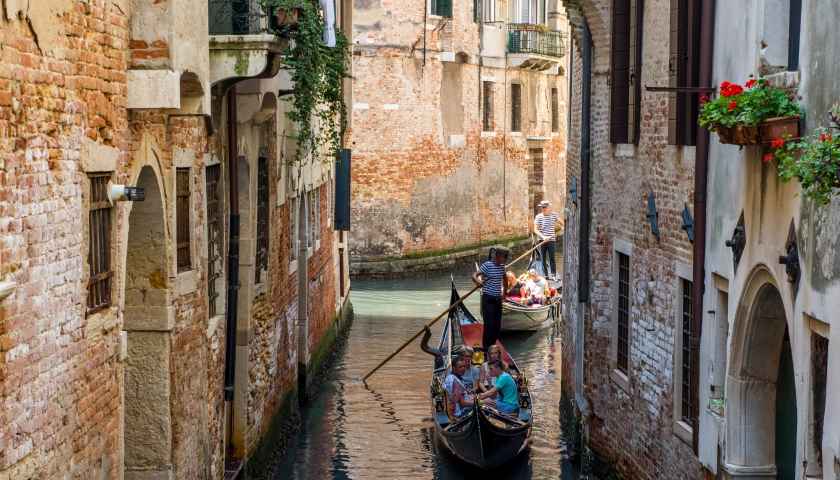A truly unique city that has canals instead of streets, and water instead of traffic. Venice is the birthplace of romance and passion, the home of Casanova, folklore and fun, and a vibrant carnival, which takes place every year just before Lent. Art is everywhere in this city, as are the gondolas!!
This crumbling city on water is like nowhere else on earth, and is one of the most special destinations in Italy. Familiarity cannot tarnish the sheer magic of this eternally beautiful, fascinating and romantic city. It has to be seen to be truly appreciated, so here are some insider tips for making the most out of your trip to enchanting Venice.
Why Go?
- Because there’s nothing else like it in the world
- Swooningly romantic canals, bridges, and 17th-century palazzi overlooking the water
- A marvelous city in which to wander about
- Artistic masterpieces, from both the Renaissance and modern-day eras
- The jaw-dropping beauty—and hugeness—of the Piazza San Marco
In sum to visit a city with no roads, to travel by gondola past grand architecture, and absorb the culture of one of the world’s most romantic cities.
What To Skip: The month of August, when hordes of tourists descend
What For: Arts + Culture, Design + Architecture, Family, Luxury, Romantic, Shopping
When To Go: May, June, July, September. To see the lagoon city at its emptiest and most atmospheric come in November, season of mists and acqua alta (tidal flooding: bring rubber boots) or January, between Christmas and Carnevale. August is sheer insanity, avoid it if at all possible. However, in any season of the year this magical city offers excesses of charm, beauty and history.
How to get to Venice
By air
Flights arrive at Marco Polo airport about five miles from the city center. To reach the city, get a water taxi or the hourly ACTV motor launch, which makes stops at Murano and the Lido before reaching San Marco.
By train
Italy high speed trains approach the city most scenically on a causeway across the lagoon from Mestre and deposits you directly on the Grand Canal. For train schedules and fares, check out the Trenitalia and Italo websites.
Getting around
Although this is a city where you'll walk endlessly, a trip to Venice would not be complete without a journey along its famous waterways. The options are endless: you can take a vaporetto which, much like a city bus, jumps from stop to stop along the Grand Canal or you can take to the water on a gondola and water taxi. Not to be confused, gondolas and water taxis are both small, private vessels which navigate the canals of Venice.
A water taxi is a speedboat while a gondola is a wooden boat, usually punted along by a man in a striped shirt. Water taxis are the faster of the two options as a way of getting from A to B. They’re also a much more practical way to travel the length of the Grand Canal. For traveling beyond central Venice by private transport to the Lido, Guidecca, Murano or Burano a water taxi is also your best.
Gondolas on the other hand, are better suited to the smaller, quieter canals of the city. They’re not so much about getting from A to B as the journey itself, so for your quintessential Venetian experience, a gondola is a given. If you have some time in Venice, we recommend experiencing both. Take a water taxi along the Grand Canal to see its 50 palaces, six churches, four bridges and two open-air markets and then (preferably around sunset), explore a quieter side of the city slipping through the canals by Venetian gondola.
A vaporetto trip on one of the public “buses” of Venice is a must for a slice of everyday life with the locals. These giant ferries run the circuit along the canal and off to the various islands in the lagoon for a reasonable price.
Insider Travel Tips
A trip to Venice is a unique experience: to make sure it's unforgottable, here some local tips to make the most of your visit.
- Venice in winter is cold and damp—also sometimes flooded—and summertime has roasting sun and mosquitoes, but whatever the season, consider leaving the Jimmy Choos chez vous. Endless walking, cobblestones, boat hopping and church-tower climbing demand flats.
- The city is also very stroller-hostile; pack the Baby Bjorn.
- Be sure to carry a map with you when traveling around Venice! However don’t be afraid to get lost, as this charming city is sure to amaze, as you never know what you might stumble upon!
- Some of the best reasons to come to Venice are for the various art, film, and architecture festivals held every year. The International Film Festival is held every August and is considered as important in the film world as Cannes. The Biennale runs for the entire summer and showcases the best in contemporary art in odd years and architecture in even years.
- Venice is crowded throughout the year with tourists so a word of advice: if you visit during the Carnival, summer season or the Film Festival, you need to book well in advance.
- There are many times of day when the Venice Lagoon is magical, but almost none is better than sunrise. Wake up at 5am one morning (just tell yourself you’ll take a nap) and walk along the Grand Canal to St Mark’s. It will be one of the few times you don’t see any people in the area.
- There’s not much nightlife in Venice, but there are plenty of tiny halls with classical music playing almost every night of the week. If you like classical, particularly Vivaldi, you’ll be in luck. Just ask the concierge at your hotel, or look around at the various billboard areas all over town.
- Getting from the airport to your hotel can be confusing. If your hotel is on a canal, you can take a water taxi directly to your front door – but be warned, this can get pricey. A more affordable option is the bus, which makes the 20-minute trip from the airport to the city center every half hour.
Venice Neighborhoods
The Grand Canal, the sweeping S-shaped waterway that snakes its way through the city’s six sestieri is the first thing most visitors see as they make their way to their hotels by water. The city is divided into six sestieri (districts), and getting acquainted with them will help you get your bearings. At the heart of the city is the bustling, heavily touristed sestiere of San Marco, where you'll find the world-famous Basilica of the same name. To the east lies the fascinatingly workaday district of Castello. Across the Grand Canal to the south of San Marco, Dorsoduro is quiet and artsy, and home to two of the city's greatest art collections: the Galleria dell'Accademia and the Peggy Guggenheim Collection.
Further north, inside the great loop of the Grand Canal, the sestieri of San Polo and Santa Croce are packed with churches. To the north, and across the canal, is Cannaregio, where five 15th- and 16th-century synagogues mark the former Jewish ghetto. Across the Giudecca canal to the south is the honorary seventh sestiere, La Giudecca, whose southern edge is lined with bustling boatyards.
Around San Marco
Heart of the city for over 1,000 years, the famed town square at the center of this neighborhood is home to the Basilica San Marco, the Palazzo Ducale, and the world’s most recognizable bell tower, the campanile. St Mark’s Square is a meeting place for tourists, locals, souvenir sellers, and pigeons (that you are not allowed to feed).
The best time to visit ‘the drawing room of Europe is early morning when the city is just starting to stir. Enjoy the peace and quiet and the morning mist whilst the cleaners sweep up. Alternatively, enjoy a coffee outside elegant Caffè Florian or Quadri – just be aware that this can set you back a small fortune, especially if musicians are playing.
Piazza San Marco is the lowest point in Venice and is subject to aqua alta, or high water, which floods the square and surrounding streets in the winter. Raised wooden platforms are assembled to create boardwalks enabling you to walk above the water. Sirens sound when the water is coming!
St Mark’s Basilica is the city’s symbol of power and wealth, with its ornate Byzantine-Venetian design, bronze horse sculptures, massive domes and gilded mosaics. It was constructed to house the relics of St Mark that Venetian merchants stole from Alexandria in 828. Inside the dimly-lit basilica you’ll notice how incredibly golden it is; the walls and ceilings are covered in gold mosaics and the altarpiece is a gemstone-covered gold panel. There are some rules in the basilica – no photos, dress appropriately, and no luggage – the last thing you want after all that queuing is to be turned away. To avoid the crowds book a private tour.
The Campanile, or Bell Tower, stands opposite the basilica. This 98-metre high tower may look ancient, but it was actually constructed in 1912 to replace an identical one that collapsed in 1902. There’s a lift that takes you to the top (good news for visitors) where you can enjoy sweeping city views. It costs €8 to visit, and be aware that the queues will be long, but it’s worth it. Aim to get there at 9 a.m. when it opens.
The grand Doge’s Palace stands next to the Basilica and dominates the waterfront at St Mark’s Basin, the gateway to Venice, with its pink stone lace exterior and Gothic-Venetian archways. This was home to the Doge, the ruler of the Republic, and it was the seat of government and a palace of justice. It’s now a museum with lavish halls and artwork. The famous Bridge of Sighs links the palace to the grim prison from where Casanova escaped; the bridge was given this name as prisoners sighed as they crossed it and caught their final glimpse of Venice. There are so many rooms to admire in the palace, but don’t miss the Sala del Maggior Consiglio where the Great Council met, and the Sala del Collegio, where the cabinet gathered – both feature frescoes by Tintoretto and elaborate ceiling paintings that you may just have to lay on your back to admire.
The waterfront promenade that runs in front of the palace to the Castello sestiere is Riva della Schiavoni – it’s lined with souvenir stalls and historic buildings, and from here you get a great view of the Bridge of Sighs and San Giorgio Maggiore island with its dazzling white Palladian church.
Around Rialto and San Polo
To reach Rialto Bridge from St Mark’s Square follow the narrow streets behind the Clock Tower called the Mercerie – shops here sell masks, leather shoes, glass and lace. Standing on Rialto Bridge gives you a wonderful view of the Grand Canal – it’s hard to believe that the authorities were once considering filling in this waterway and turning it into a road. This intricately designed stone bridge, with shops housed in porticoes on each side, is the most beautiful of all four bridges that cross the Grand Canal. And it’s usually swamped with tourists.
Across the bridge is the San Polo sestiere and the Rialto Market, Venice’s main fish and produce market which has been around for almost 1000 years. A morning stroll around this colorful, chaotic open-air market is a great way to experience local life. San Polo is the oldest sestiere; wander into the heart of this neighborhood to escape the crowds and stumble upon crumbling churches and squares, including the large and dusty Campo San Polo. Visit Chiesa di Santa Maria Gloriosa dei Frari, a church decorated with paintings by Titian and home to his tomb. Seek out Ponte delle Tette, the ancient red-light district in the 14th century where courtesans lived and practiced their trade, displaying their wares from nearby windows.
Around Dorsoduro
South from San Marco, the appeal of this crowded neighborhood across the Grand Canal can be summed up in one word: art. The city’s two world-renowned museums, the Peggy Guggenheim Collection and Galleria dell’Accademia, are within easy walking distance of each other.
The Squero di San Trovaso is one of the last remaining gondola workshops in the city and the oldest. Watch the gondola builders at work by standing along the Rio di San Trovaso; they don’t mind, as long as you don’t try to go inside.
The Zattere is a great place for a sunset stroll, or passeggiata, with a gelato – this peaceful promenade at the southern edge of the sestiere offers fantastic views of Giudecca island with its Redentore church, as well as beautiful buildings like the Baroque church of Santa Maria del Rosario.
Around Cannaregio
The large Cannaregio Canal feels as big as the Grand Canal (it was the main route into Venice before the railway) but there are noticeably less tourists. Cannaregio is a very residential and peaceful sestiere away from the main shopping streets. Visit the gorgeous 15th century Ca’ d’Oro which faces the Grand Canal – this well-preserved building was once covered in gold and houses an art gallery; stand in the courtyard with its mosaic floor and admire the canal from the loggia. There are shorter queues here than for the attractions around San Marco.
The Jewish Ghetto is tucked behind the Cannaregio Canal. All the Jews in the city were made to live here between the 16th and 18th centuries, and it’s still home to Venice’s small Jewish community; you can see where its entrance and exit gates once stood. Surrounding the main square you will see the Venice ‘skyscrapers’– there wasn’t much room in the ghetto so higgledy-piggledy buildings of up to 7 floors were constructed. It’s a pleasant area and home to the Jewish Museum.
Outlying Islands
Venice’s canals are probably its most famous attribute, but travelers should take the time to visit the island villages found in its lagoon. Murano, Burano and Torcello are three famous hamlets found in the Venetian lagoon; the first two are known for their handicrafts, while Torcello is known as the first sign of civilization in Venice. If you get the chance take a trip out to the outlying islands, you can book a private guided half-day tour that takes you via motor boat to these charming islands, described below.
Murano is ten minutes away, which is the largest island and famous for its glassware. Don't miss the opportunity to see glass-blowers at work; it certainly requires extreme skill to take a lump of glass and turn it into glassware. Nearly all the shops on the island cater to the glass trade, and more glassware can be admired at the Museo del Vetro, which displays the history of Venetian glass through the course of time.
Thirty-five minutes from Murano is Burano, a sleepy fishing island famous for brightly painted houses and lace. In this little town, the houses are painted in varied bright colors, giving a picturesque and cheerful character to the setting, which kids always love. Burano is famous for its lacemaking, a skill that has developed here since the 16th Century; various shops offer lacemaking demonstrations.
Torcello, five minutes from Burano, is marshy and half-deserted but has an amazing medieval church – this was the first island that was settled in the lagoon, so you can see what Venice would’ve once looked like. The Basilica di S.M. Assunta di Torcello is the oldest cathedral of the lagoon and evidence of the first settlement here. Its interior is enriched by splendid decorations with particularly striking mosaics.
Romantic Things to Do in Venice
If Rome is history, Venice is romance. This is the city of Casanova and while I am not suggesting anyone follows his model of multiple seductions, Venice is clearly a place that turns the mind to romance. The sheer beauty of the place brings the senses alive: the churches and palazzos rising out of the mists or glowing in the sunsets, the sounds of water lapping as gondolas float past and hidden voices and laughter echoing around the narrow canals, and the tiptap of footsteps on stone, the tastes of delicious foods.
Nothing conveys the romance of Venice like a gondola. These elegant, black, hand-built wooden boats have been an unmistakable feature of the city for almost 1,000 years! On any romantic trip to Venice, you must have a private gondola ride down the Grand Canal at sunset. Tucked into the gondola with your loved one you’ll be away from the crowds and see this unique city the way it is meant to be seen: from the water!
With its maze of canals and decaying, sienna-colored buildings, the famously sinking city of Venice is unmatched for romance, even when it’s mobbed with tourists (as it usually is). Finding somewhere to be alone together in Venice can be quite challenging but the city does quieten down at night and you might find yourselves alone on the Accademia Bridge after 9pm, or even have St Mark’s Square pretty much to yourself after about 11pm if you want to propose in magical surroundings.
Heading out to some of the islands will give you a bit more peace and quiet too. Taking a private tour to Murano and Burano is lovely, or head out on the vaporetto to Giudecca island (stop: Zitelle) and sit on the benches looking across the water towards San Marco and the Doge’s Palace. The Hilton hotel on Giudecca has a rooftop Skyline Bar.
Taking a picnic to the Giardini Pubblici, the gardens at the end of the main island in Castello, along from San Marco, which is a green oasis in Venice, is lovely. This is where the art biennale is held every odd-numbered year so in mid-summer of those years areas might be off limits, but the rest of the time, it’s great to wander through. From the waterfront here you’ll get great sunset views.
One of the best things to do in Venice is to just wander, get lost, and discover – this goes for churches which are hidden around so many corners and in tiny back squares and nearly all have something wonderful to see inside, as well as for restaurants and bars. You’ll find your own special places – and be hard pressed to ever find them again: that’s Venice – mysterious, secretive, surprising.
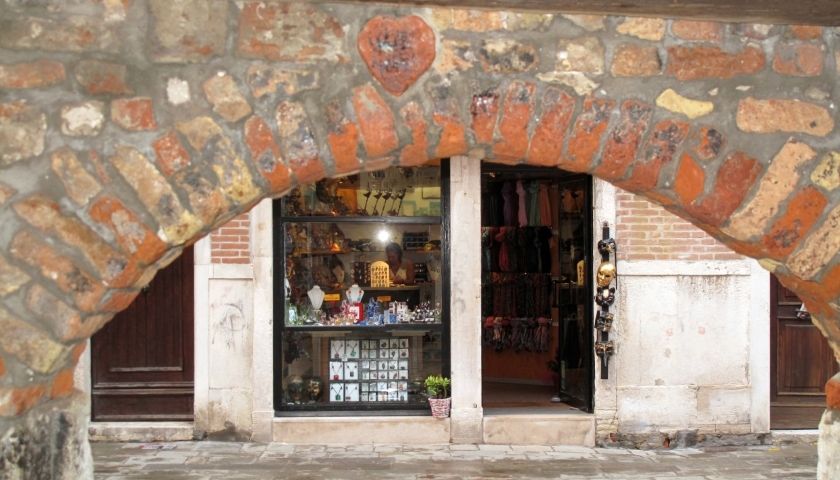
But one very magical place you must find is the lover’s heart embedded in a wall. The street name is Sotoportego dei Preti. It is more a small passageway between two houses and the heart is just above the low arched entryway. To get there find Campo de la Bragora off the Riva degli Schiavoni and head up Calle del Dose, to Via Salizada del Pignater. From here, you’ll find Sotoportego dei Preti. If you are in a relationship, touch the heart together and your love will be eternal. If you are single touch the heart alone and you will find love within one year. Or so the legend goes. Planning a romantic escape to this Italian wonderland? Rekindle a long-standing romance, or kick a new one up a notch with this romantic getaway in Venice.
Venice hotels
You'll have no trouble finding a hotel in Venice: The city has survived on tourism since the early 18th century. And since most of Venice's lodgings occupy historic buildings that are hundreds of years old, finding "character" isn't much of a problem, either. Getting good value for your money, though, is more challenging.
At the top end of Venice hotels, there's a huge choice: Grand palazzi line the canals around the Piazza San Marco and also the Lido. Lower down the price ladder, the scene has been shaken up in the last few years by the arrival of B&B–style guesthouses. These range from charmingly simple options to luxurious homes that once belonged to the nobility—and in some cases still do. Unfortunately, many of Venice's established two- and three-star hotels tend to rest on their laurels, providing the bare minimum at rates that would be considered exorbitant anywhere else. Our recommendations in this category are among the exceptions.
The ever-growing number of beds available means that Venice hoteliers have a hard time filling their establishments in quieter moments. It pays to check Booking where you're likely to find some excellent low-season deals, even hotel rooms for under €200. And a word for first-timers: The Lido—a pleasant, beach-lined dormitory island—is a long boat ride away from the city's major sights, and the only time it comes alive is during the film festival in early September.
Information may have changed since date of publication. Please confirm details with individual establishments before planning your trip.
5-star Hotel Gritti Palace, San Marco
Built on the Grand Canal in 1525 for then-doge Andrea Gritti, this magnificent palazzo has lost none of its pomp and ceremony. Now part of the Starwood Luxury Collection, the hotel has museum-quality art and antiques filling its public spaces. The 91 guest rooms and suites are outfitted in traditional, opulent Venetian style, with massive Murano glass chandeliers, intricate painted wood paneling, and sumptuous brocades. Just three of the first-floor suites have breathtaking views over the canal, but vista-deprived guests can console themselves with a terrace table at the hotel restaurant. Book your stay.
5-star Hotel Danieli, Castello
Rubbing shoulders with the Doge's Palace and the Bridge of Sighs, the Danieli has been a hotel since the early 19th century. Back then, it was the choice of Grand Tourists like Charles Dickens and Richard Wagner. Now part of Marriott's Luxury Collection, the 210-room hotel (in 13 categories) spreads from its original 14th-century palazzo to incorporate two 20th-century buildings. Throughout the hotel, rooms are outfitted with Fortuny and Rubelli fabrics, and while antiques adorn the magnificent Venetian Gothic reception hall, the ambience is more Hollywood mansion than aristocratic palazzo. The view from the roof terrace across the Bacino di San Marco to the Basilica di Santa Maria della Salute is stunning. Book your stay.
4-star Ca Maria Adele, Dorsoduro
Opened in 2004, this boutique hotel right near the Peggy Guggenheim Collection achieves what so many others have failed to pull off: It seamlessly mixes Venetian traditions and modern design, with stunning results. From the striking reception area, where Byzantine columns rise out of a pool of water, to the sheet-glass door opening onto a private boat mooring, to the 12 stylishly decorated bedrooms, Ca Maria Adele has single-handedly redefined what elegant lodging looks like in this town. The nine "deluxe" rooms (two of which are suites) are restful and sophisticated, with minimalist wood furniture and damask wall coverings in colors of sand and cream. The five "concept" rooms, however, really push the envelope; check the photos on the hotel website before you book to make sure you can deal with the seriously sensual black Sala Noir or the overwhelmingly scarlet Doge's Room. The blue-tinted Sala dei Mori, with its tiny balcony overlooking the Salute church next door, is our favorite. Only the bathrooms—which are large and well-appointed but strangely neutral—are a slight disappointment. Book your stay.
5-star Sina Centurion Palace, Dorsoduro
Few properties have a more enviable address: Right at the mouth of the Grand Canal, facing St. Mark's Square, the imposing nineteenth-century redbrick palazzo manages to be centrally located (the wonderful Punta della Dogana Pinault Collection and the spectacular Santa Maria della Salute church are just steps away) yet feel apart from the city's bustle of tourists. The 50 one-of-a-kind rooms and suites, some of which have fireplaces, feel intimate and contemporary, with light-wood floors, bathrooms lined with exquisite gold-leaf treatments, and custom furniture in burnished shades of orange, light pink, and blue velvet. (Try to snag a water view, and note that rooms on the courtyard are quiet but smaller). Book your stay.
Charming House DD724, DD694, and IQs, Dorsoduro
When it first opened, around the corner from the Peggy Guggenheim Collection, in 2003, DD724 was considered a huge departure (some say a refreshing one) from the traditional damask-and-chandelier lodgings elsewhere in the city. Nowadays, though its neutral tones and wenge wood don't seem so shocking, it still attracts those who can't take another fresco or brocade swag. The owner's collection of contemporary Italian art hangs on the walls, and chairs covered in checked Frigerio prints add a touch of mod. Most of the six bedrooms are spacious enough (unit G overlooks a walled garden, and B has a pretty view out of windows on two sides), but the bathrooms, breakfast room, and corridors all feel cramped. Finding the hotel entrance can be a bit challenging, too: The sign high on the wall of the cul-de-sac is easily missed. The hotel has two sister properties: DD694, a large suite even closer to the Guggenheim, with original terrazzo flooring that adds a splash of antique Venetian warmth to the cool shades-of-brown design mix; and newly arrived IQs, a four-suite luxury home-from-home with its own porta d'acqua (water-level entrance) in a Gothic palazzo north of St. Mark's. Daring to be dark in this city of light, the suites' sober decor is enlivened by splashes of color (a red Moroso armchair, a vase of flowers) and given depth by rich materials (leather, mosaic, fur, and crystal). In winter, the somber color scheme can feel oppressive, but in summer it's a soothing refuge from the heat and glare outside. Book your stay.
3-star La Calcina, Dorsoduro
Continued improvements have spruced up this family-run pensione overlooking the Giudecca canal in Dorsoduro. The 19th-century furniture is still there, as are the lovely—and, for Venice, unusual—polished parquet floors. But the hotel's 32 rooms and suites now have WiFi, TVs, and minibars, as well as crisp white curtains and clean-lined furnishings in honey-colored wood. In the reception area, classical music wafts and friendly staffers give advice about where to go and how to get there. The terrace of the bar-restaurant is on a wooden deck extending into the canal; eating breakfast here on a sunny morning with boats passing by and the church of the Redentore across the canal is heavenly. All told, this has become one of the best-value places in its category. Book your stay.
3-star La Villeggiatura, San Polo
On a busy calle in the San Polo district, this six-room charmer is one of the most attractive of a crop of new Venetian B&Bs. It's basically a traditional apartment on two floors that has been jazzed up by owner Francesca Adilardi, who has a flair for playful, decorative design. Each room is themed: In light-filled Mondo Nuovo, under the rafters, a reproduction of the famous Tiepolo carnival fresco of the same name takes up most of one wall, while pretty Turandot features throws on the bed and Chinese-style stenciling on the otherwise grandmotherly antique furniture. The overall effect is theatrical, feminine, and fun, but there's also a satisfying attention to detail. Beds are huge, bathrooms well appointed (though only three of the six have tubs), and all rooms have free Wi-Fi. Book your stay.
3-star Al Ponte Mocenigo, Santa Croce
This ten-room gem near the church of San Stae is easily one of the best deals in Venice. Guests enter the Mocenigo through a private courtyard where aperitivi are sipped and breakfast is served in good weather; that relaxing welcome sets the tone for the whole place. Rooms are elegant and airy, upholstered in cream, green, and deep red, and furnished with a mix of 18th-century pieces. Our favorite: the large first-floor junior suite with a four-poster bed, a terrace overlooking the courtyard, and a whirlpool tub. Book your stay.
5-star Ca' Sagredo, Cannaregio
This gorgeously restored fifteenth-century palazzo on the Grand Canal benefits from its ideal location: near the Rialto but outside the fray around San Marco. The historical tour offered at check-in is worth your time: Among the highlights are original frescoes by Giambattista Tiepolo and Pietro Longhi in the grand hall, a high-ceilinged ballroom with oversized windows overlooking the canal, and huge Murano chandeliers—all of which conjure the masked balls that once took place here. The 42 guest rooms are beautifully appointed with sofas and chairs covered in pale silk damask and custom wallpapers in pretty, light patterns, and all come with large bathrooms. Book your stay.
Hotel Cipriani, Giudecca
Cloistered among sweeping, verdant grounds on the island of Giudecca, across the Grand Canal from Piazza San Marco, the Cipriani is a luxurious world unto itself. It's frequented by the ultrarich and the ultrafamous—many of whom never even bother to take the hotel's private launch across to the bustle of Venice proper. For them, the Cipriani, with its restaurants, bars, tennis courts, spa, and Olympic-size saltwater pool, is its own destination. The decor in the public spaces and 104 rooms is mostly opulent, with lashings of silk brocade, murals, frescoed and gilded ceilings, and all-marble bathrooms—though bedrooms not yet touched by an ongoing refurbishment effort are (at this price) frustratingly faded. The service is formal, at times even a little frosty. If you simply can't cope without a private butler and space for an entourage, opt for the 11-suite Palazzo Vendramin or the five-suite Palazzetto Nani Barbaro, across the garden from the hotel. But be sure to book far in advance: These mini-palazzi are popular with visiting sheiks and their security staff. Book your stay.
Eating and Drinking in Venice
Venice can be an incredibly expensive city to eat in, but if you veer off the main tourist thoroughfares, you can find some great places. Many Venetian specialties involve seafood such as spaghetti alle vongole, spaghetti with clams, risotto alle seppie, risotto stained with cuttlefish ink and anguille in umido, stewed eels with tomato, garlic and wine. Other traditional dishes include fegato alla veneziana, calf’s liver with onion, and bigoli con l’anatra, thick spaghetti with duck.
For a simple, inexpensive lunch, eat tramezzini; crustless sandwiches with tasty fillings. Venice also has its own tapas, or cichetti; you can move from bacaro to bacaro (bar) filling up on these small delicious morsels such as polenta topped with polpetta, small meatballs, or sardelle in soar, sardines, washed down with a glass of prosecco, Venetian sparkling wine, or spritz, a Venetian aperitif. Here are some suggestions about some of the best wine bars in Venice.
Planning a Trip to Venice?
Want to get under the skin of Venice, but don't want to deal with planning? Our team is here to help. Take our private tours and leave the planning up to us! Plus, you'll have an informative Venetian guide to tell you all about the sights, so you can experience this unique city like a local.
 Rome & Vatican
Rome & Vatican Venice
Venice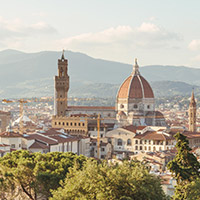 Florence & Tuscany
Florence & Tuscany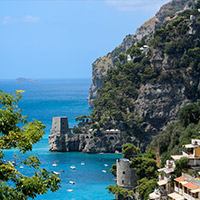 Napoli & Amalfi Coast
Napoli & Amalfi Coast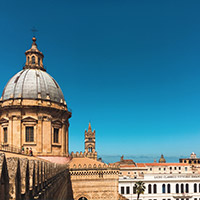 Sicily
Sicily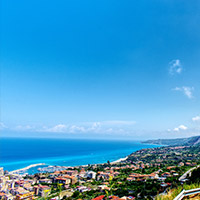 Calabria
Calabria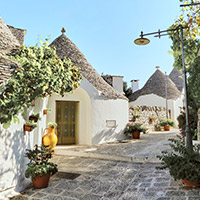 Matera & Puglia
Matera & Puglia